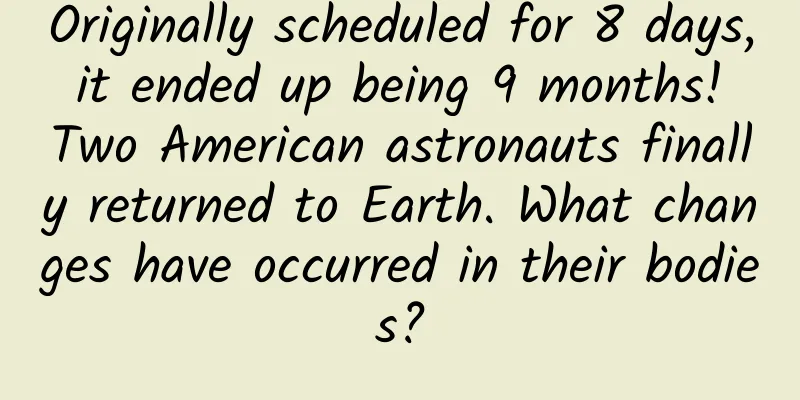Originally scheduled for 8 days, it ended up being 9 months! Two American astronauts finally returned to Earth. What changes have occurred in their bodies?

|
American astronauts Wilmore and Williams, who had been stranded on the International Space Station for more than nine months, returned to Earth on the Dragon spacecraft of the Space Exploration Technology Company of the United States on the 18th Eastern Time. Also returning were American astronaut Nick Hague and Russian astronaut Alexander Gorbunov. According to NASA's live broadcast, the "Freedom" "Dragon" spacecraft carrying the four "Crew-9" mission astronauts left the International Space Station at 01:05 EST on the 18th (13:05 BJT on the 18th) and set off for home. After nearly 17 hours of flight, the spacecraft splashed down in the sea near Florida at 17:57 EST on the 18th (05:57 BJT on the 19th). So far, the two American astronauts have finally ended their more than nine months of "unexpected overtime" in space and returned to Earth. The recovery ship waiting near the splashdown site salvaged and safely recovered the spacecraft. After the spacecraft was lifted and fixed on the deck, the hatch opened and the four astronauts exited the cabin one by one with the assistance of the medical team. They waved to the welcoming team with smiles on their faces. It is reported that they will undergo routine medical examinations and then fly to NASA's Johnson Space Center in Houston to reunite with their families. ▲On the morning of the 19th, Beijing time, the Dragon spacecraft landed near the coast of Florida Boeing's Starliner is trapped due to a malfunction The reason why the space journey of 62-year-old Wilmore and 59-year-old Williams has encountered so many twists and turns is that it all started with the unsuccessful first manned test flight of Boeing's "Starliner". In 2014, Boeing and SpaceX both received NASA contracts for manned spacecraft projects. However, Boeing's Starliner development process was not smooth, with problems emerging one after another, so that the project development progress lagged far behind SpaceX. It will not be until June 2024 that the Starliner will have the opportunity to conduct its first manned test flight. On June 5, 2024, astronauts Suni Williams and Butch Wilmore boarded the "Starliner" and took off from Cape Canaveral, Florida. They arrived at the space station on June 6 and were scheduled to return on June 14. However, before the spacecraft took off, a helium leak occurred in the propulsion system, followed by four more leaks during the flight, and even five thrusters went offline. Although the Starliner successfully docked with the International Space Station and underwent a large amount of data review and testing during the docking, due to the inability to rule out potentially dangerous uncertainties and the lack of consensus among the experts conducting the review, NASA ultimately determined that the Starliner was not suitable for continuing with its manned return mission and decided to let the spacecraft return to Earth empty. As a result, Sunny Williams and Butch Wilmore had to stay in space and wait for NASA to arrange another spacecraft to take them home. The original eight-day "business trip" in space turned into an indefinite "permanent stay" in space. Obviously, Boeing was not up to the task, so NASA had to choose Space X's "Dragon" spacecraft. In order to bring back Sunny Williams and Butch Wilmore, NASA and SpaceX had to adjust the original space capsule and crew configuration of the upcoming Crew 9 mission, which further delayed the return home time of the Crew 8 mission members of the International Space Station. On March 3, 2024, the four astronauts on the Crew 8 mission were sent to the International Space Station by the Dragon spacecraft. They were originally scheduled to stay in the space station for 6 months, but because of the postponement of the Crew 9 mission, their return time was delayed by nearly two months, and they will not return to Earth until October 25, 2024. In September 2024, Crew-9 mission commander Nick Hague and another astronaut Alexander Gorbunov boarded the Freedom Dragon spacecraft to the International Space Station. Normally, SpaceX's Dragon spacecraft will transport four crew members to the International Space Station, but this time the Freedom Dragon spacecraft only carried two crew members, in order to reserve seats for Sunny Williams and Butch Wilmore. It is worth mentioning that as the Crew-9 crew entered the International Space Station, the stranded Sunny Williams and Butch Wilmore also joined the crew and became part of the Crew-9 mission. Many people are curious, since the Crew-9 mission has arrived at the space station, why not send Sunny Williams and Butch Wilmore directly back to Earth? This is because the Crew series mission is an international space station crew rotation mission undertaken by SpaceX, which has a set plan. Letting them continue to stay on the International Space Station as part of the Crew-9 mission is the plan with the least impact on NASA's existing launch plan and the lowest cost. On March 16, 2025, the four astronauts of the Crew-10 mission successfully arrived at the International Space Station on the SpaceX Endurance Dragon spacecraft. They replaced four crew members of the Crew-9 mission, including Sunny Williams and Butch Wilmore. According to the Associated Press, Wilmore and Williams spent a total of 286 days in space, flying 4,576 times around the Earth and covering a distance of 121 million miles (195 million kilometers). However, during the nine months they stayed on the International Space Station, Wilmore and Williams also gained a lot. In addition to participating in relevant scientific experiments and technical demonstrations, they also conducted many spacewalks. Among them, Williams conducted nine spacewalks, with a total duration of more than six hours, setting a record for the longest spacewalk by a female astronaut. Long-term stay in space may affect astronauts' health During the whole process, the ones most affected were Sunny Williams and Butch Wilmore, and the outside world was also very concerned about their health. In fact, on the International Space Station, astronauts tend to follow a rigorous schedule of exercise, work and leisure, and they exercise regularly on treadmills and resistance machines to maintain their bone and muscle strength. In November 2024, Williams also said in an interview with the media that she and Wilmore "felt good" and "those who are worried about us don't have to worry too much about us. We are very happy here." In January of this year, the two of them also conducted a spacewalk together. But according to a report by CBS in late January 2025, after being stranded in space for about seven months, Williams admitted that her basic body movements had been affected to a certain extent. She said: "I'm trying to get the feeling of walking back. I didn't walk, sit down, or lie down in space. Previously, photos of Williams with a "cone-shaped face" circulated on the Internet. In the photos, she was skinny and haggard, causing many people to worry about her health. However, Williams insisted that she was in good condition and she and Wilmore did not feel abandoned. Vinay Gupta, a pulmonologist in Seattle, USA, said that Williams' "cone face" phenomenon is mainly due to fluid transfer and weight loss in space. In addition, astronauts will face many other challenges in their bodies after entering space. For example, on Earth, gravity exerts pressure on bones and muscles, prompting bones to constantly reshape to adapt to the needs of the body. However, in the microgravity environment of space, bones are no longer subjected to the same pressure as on Earth, which can lead to a decrease in bone density and muscle atrophy. Scientists have found that after astronauts stay in space for a period of time, they will lose about 10% to 20% of their muscle mass. This means that they cannot fight against the gravity of the earth when they return to the earth, so astronauts in space will do 2 hours of high-intensity exercise every day to reduce muscle atrophy. After entering space, the human body loses the gravity that pushes down on the spine, so astronauts will grow taller. On Earth, our spine is curved and has a normal curve. But in space, our spine is like a piece of curved paper that is flattened. After measuring the spine, it was found that the height of astronauts can even increase by 6 to 8 centimeters! Although they grow taller, their bodies are in pain. This "growing taller" pain can even wake up astronauts in their dreams. In addition to muscles and bones, body fluids are also affected by the microgravity environment of space. Under the action of gravity, blood and other body fluids are naturally pulled to the lower body, but after entering space, gravity disappears and blood tends to gather in the upper body, causing swelling of the face and upper body. In space, astronauts' blood volume will also decrease, causing their heart rate to slow down, which in turn leads to low blood pressure. However, astronauts do not feel low blood pressure when entering space. Instead, they will clearly feel the blood flowing back to the lower body and the blood pressure in the head suddenly drops after returning to the atmosphere and landing. They will then feel dizziness and be unable to adapt to walking upright for a while. In addition, long-term living in space means keeping away from family, friends and even the entire society. This isolation will bring a deep sense of loneliness and affect the health of astronauts. For example, astronauts on the Salyut 7 space station in the last century developed symptoms such as irritability and sleep disorders when they were on a 7-month mission. In addition to being away from family and friends, the small and enclosed aircraft, high-risk missions, and long periods of confinement will all cause psychological stress for astronauts. World record for longest single space flight: 437 days, 17 hours, 38 minutes Spending too much time in space can take a toll on the body and mind, but Wilmore and Williams' expedition is not the longest spaceflight in history. In 1995, Russian cosmonaut Valery Polyakov set the world record for the longest single spaceflight in history, spending 437 days, 17 hours and 38 minutes in space and orbiting the Earth 7,075 times. The person with the longest cumulative stay in space in the world is also a Russian astronaut. In 16 years, he went to the International Space Station five times, with a total flight time of an astonishing 1,110 days in space and flew around the earth 16,000 times. Why can Chinese astronauts return to Earth on time? As the American astronauts who had been stranded in space for 9 months finally returned home, some netizens were curious whether a similar situation of astronauts being "stranded" would occur on the Chinese space station. On March 19, the topic of "Why can Chinese astronauts return to Earth on time?" became a hot search topic. In this regard, Yang Yuguang, chairman of the Space Transportation Committee of the International Astronautical Federation, said that when any of our astronaut crews stay in the Tiangong space station for half a year, there will be a Long March 2F carrier rocket and a Shenzhou spacecraft on standby on the ground. Once the astronauts in space encounter danger, we only need a very short time to complete the comprehensive testing of the rocket and spacecraft and bring the astronauts in space home as quickly as possible. Experts said that in addition to the "one master and one backup" mode, the Shenzhou spacecraft is also more intelligent. Pang Zhihao, an expert in aerospace science, said that the Shenzhou spacecraft has the ability to return autonomously in an emergency. The equipment on the spacecraft can automatically identify and handle faults. In the event of an emergency fault during autonomous flight, it can return to the ground at any time. If the spacecraft fails during the automatic docking process with the space station, the astronauts can manually complete the rendezvous and docking. After docking, if the space station has a fault that seriously threatens the life safety of the astronauts, the spacecraft also has the ability to evacuate the space station and return to Earth at any time. Source: CCTV News, Xinhua News Agency, 21st Century Business Herald WeChat Account, China Science and Technology Museum, Red Star News |
<<: Repeated oral ulcers may not be simply caused by "getting angry"! Be careful of this disease
Recommend
Talk about XP is a pirated user after April 8
Microsoft will officially stop technical support f...
Summary of 7 commonly used sorting algorithms in Java
I have been free for a while, so I took some time...
Apps with data - data expressions on mobile phones
Previously, I studied the best way to express dat...
How can products be promoted effectively?
Many people write brilliant copy and make beautif...
2015 App Store Submission Review Guide (Part 1)
Introduction: When uploading new products to the ...
The fastest animal in the world may be a relative of your bed! | Species Chat
In 2014, a mite named Paratarsotomus macropalpis ...
The “New World” of Mobile Applications Going Global
The story of Columbus's discovery of the New ...
Where is the keychain on my father's waist?
I don’t know if you have noticed that the bunch o...
Where is the Changsha Tea Club located? How can I contact you for high-end part-time takeaway and tea drinking?
Where is the Changsha Tea Club located? How to co...
Pit and fissure sealing: Let your child's teeth resist "sugar-coated bullets"
After seeing this picture, you must be wondering,...
Following televisions, mobile phones are also experiencing a surge in price. Is the worst really over?
"The main theme of the mobile phone industry...
Mobile terminal ecosystem report: Xiaomi and Apple are eye-catching, while Samsung is bleak
Weibo recently released a smartphone report based...
WOT2016 Wang Qingyou: Listen to the Chief Architect Discussing Large APP Server Architecture
The WOT2016 Mobile Internet Technology Summit wil...
How to become a professional live broadcaster?
“Qualified anchors rely on teaching, professional...









